Farm to Table with The Kilted Chef
Last week, a man in a kilt made my dreams come true.
It’s okay, my husband knows about it.
As a home cook whose enthusiasm sometimes borders on the obsessive, I have always wanted to follow a chef around for a day. I wanted to feel firsthand the inspiration that a trip to a vegetable garden can spur on in a culinary artist; to have someone correct my disastrous knife skills before I lost a thumb; to get all the inside secrets about great cuisine without necessarily having to withstand the heat and clog-wearing involved in professional kitchen service. Enter Alain Bossé, aka The Kilted Chef
A champion of Nova Scotia cuisine and locavore extraordinaire, Alain offers full-day farm-to-table cooking classes at his Pictou County home. Arriving at their refurbished farmhouse overlooking the ocean, foodies can expect a warm welcome from Alain and his business partner/wife Johanne, only to be whisked away to spend the morning grocery shopping like most of us have never grocery shopped before.
Myself and four others drove through heavy mist a couple Saturdays ago, soon finding ourselves greeted by a blast of humid air carrying the heady aroma of smoked meat as we stepped into The Pork Shop.
Venturing behind the counter and back into the processing area, Alain gave us a tour of the facility, showing us huge smokers that billowed with the scent of wood chips and bacon, explaining how sausage is made, and breaking off pieces of zippy pepperoni and beautifully seasoned cold cuts for us to sample.
It was here that we picked up some bacon for the lobster chowder that we were going to make that afternoon. Knowing that my husband was home caring for a zany, teething toddler so that I could spend the day pretending to be a chef, I bought him some sausage stuffed bacon, dried pepperoni, bacon wrapped capacola steak and, because he’s a Newfie boy at heart, some bologna. There was such a huge range of product to choose from at the Shop that I could hardly choose but a few.
Our next stop was North Nova Seafoods, a seafood processing and packing plant tucked unassumingly down a tree-lined dirt road. After donning our classy looking hair and boot covers, Alain toured us through the plant – busy with throngs of workers crushing, tossing and sorting lobster parts. With a capacity to process up to 300,000 pounds of lobster per day, you can only imagine the din of conveyor belts, the clomp of over-sized rubber boots dutifully travelling between sorting stations, and the seas of red and white shell piled up on work tables. Though the five of us tried to be as conspicuous as possible, as one worker noted, “it’s not every day you see a guy in a kilt walking through a fish plant.”
We stood in the mist and watched a few lobster boats come in and offload their catch and before leaving, we visited Logan’s Seafood Shack, an outbuilding that does a small retail business of North Nova’s products for local consumers. With a half a dozen wily lobsters and a couple packages of rock crab in the cooler in the back of Alain’s truck, we were off to our next stop.
The vegetables and herbs for our afternoon culinary activities were sourced from Lakenman’s Farms. The owner of the small, family-run business gave us free reign of the facility, and we pulled up baby carrots and beets, snapped off stalks of asparagus, tore giant leaves from long rhubarb stems, and sampled the pungency of garlic chives before grabbing a handful to use for garnish.
Our final stop was Ferguson’s Abbatoir. Another unassuming facility, unless you come on a day when the cattle are herded in and never brought out again. Well, they are, I guess, but in the form of tenderloin. I was fascinated to learn about the process by which meat arrives on my plate, and came to appreciate the art of butchery and the pride that the small-scale local operation takes in its’ work.
Back at the farm, Johanne had fresh homemade scones with lemon curd, whipped cream, and flutes of champagne awaiting us. I somewhat reluctantly wiped the lemon curd from my chin and put down my sparkly so as to maximize my capacity to take in the first lesson of the day: knife skills.
Knife skills are essential to chefs and home cooks alike. Not only do we all want to make sure our food is cut into pretty shapes (you want that, right?) but I would estimate that we all appreciate our fingers and thumbs, particularly when intact. Using a very sharp knife incorrectly, I don’t have to tell you, can be disastrous.
We began with very sharp knives indeed: as a part of the cooking class, each participant was given a made-in-Pictou-County Grohmann Chef’s knife and paring knife. **Score!!** I wrapped my fingers somewhat clumsily around the hilt of my new chef’s knife and began slicing and dicing carrots into the matchstick, brunoise, bias, dice and julienne cuts that Alain had demonstrated for us.
It was a little nerve wracking at first, but with Alain’s watchful eye and careful guidance, I soon began to shed some of my old habits and pick up confidence and speed with the new techniques.
The menu we were preparing that afternoon included an amuse bouche of curried carrot soup, Northumberland rock crab cakes with dill remoulade, lobster chowder with sweet basil and brie, slow roasted beef tenderloin with a maple ginger sauce, honey and chili roasted Annabelle potatoes, fresh carrots, beets and asparagus, and a panna cotta with rhubarb compote.
The large majority of the ingredients for our food were sourced during our morning “shopping” trip.
Very quickly, the kitchen began to warm and produce the enticing aromas of sautéing onions. As the group of five of us learned to maneuver around the kitchen and each other, we were taking in vast quantities of knowledge courtesy of Chef Bossé.
We learned how to use our hand to estimate the done-ness of meat, how to avoid getting mauled by a lobster, and how to trim tenderloin. We also picked up a few other colourful bits of information, such as how lobsters mate.
The afternoon passed quickly and just as our feet were beginning to tire and our wine glasses beginning to empty, we headed into the final push towards dinner service. Each of us took turns plating a course and we sat around Alain’s dining room table proudly chowing down on what was probably the freshest meal most of us had had in a long time.
Now that we had time to slow down, I took the opportunity to chat with Janice Ruddock, who, during the week, is executive director of Taste of Nova Scotia but today was a student of Alain’s alongside the rest of us. She shared that the class represented the epitome of what Taste of Nova Scotia wants to cultivate in our province: an appreciation and knowledge of the incredible food that is grown, fished and produced in our own back yards, and the know-how to use those ingredients to put great food on the table. I couldn’t agree more.
Is Pictou County a culinary hotspot in Nova Scotia? Not necessarily. But, in Alain, what it does have is a passionate resident whose desire to choose local products and support farmers, fishers, and other food producers has fostered their ability to flourish.
Though the lobster chowder was beyond-belief decadent and my fingers have been a lot safer from the blades of my kitchen knives, I think my favourite part of this dream-come-true opportunity was seeing the significant impact that a consumer’s choice to buy local truly has on Nova Scotia’s food industry.
For more information, or to sign up for one of the Kilted Chef’s cooking classes, click here.

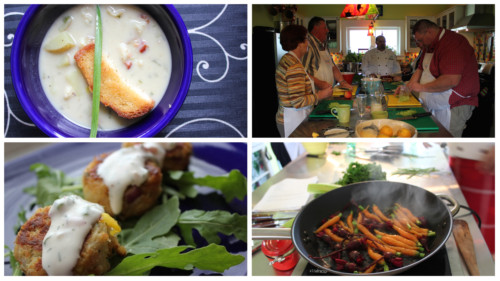

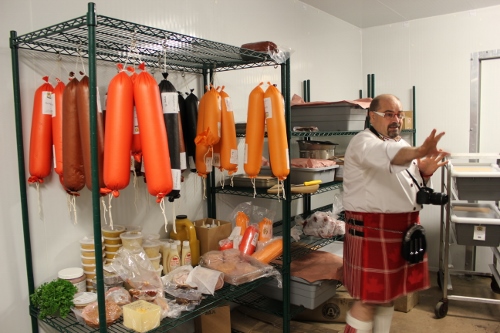
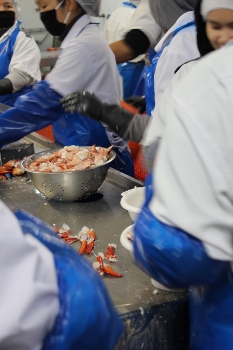
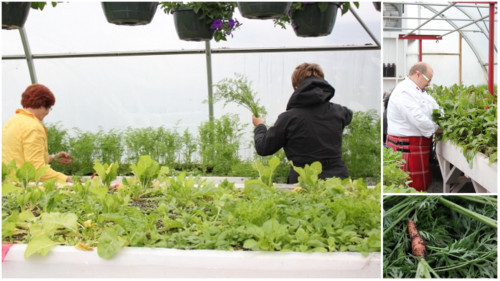
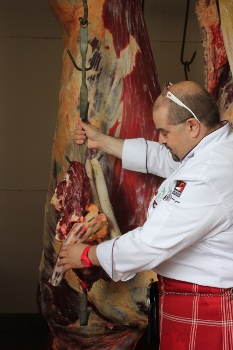
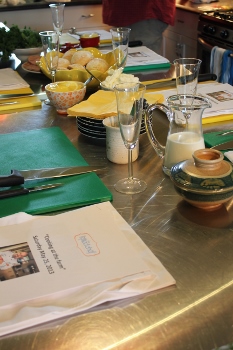
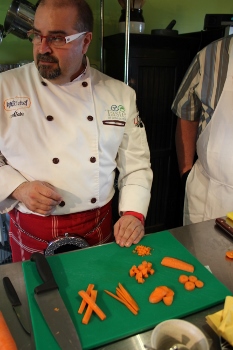

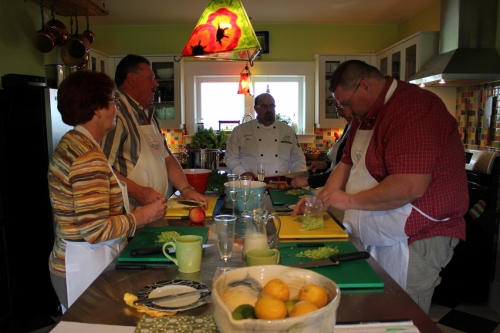
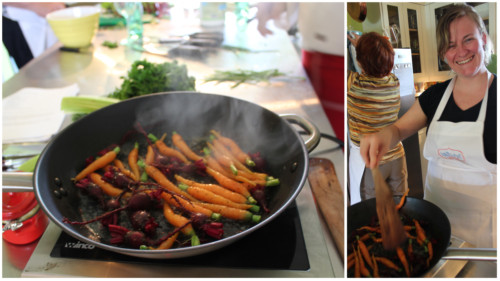
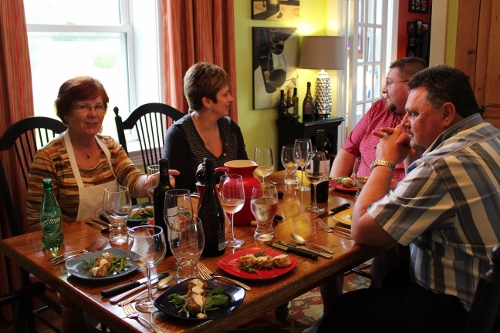
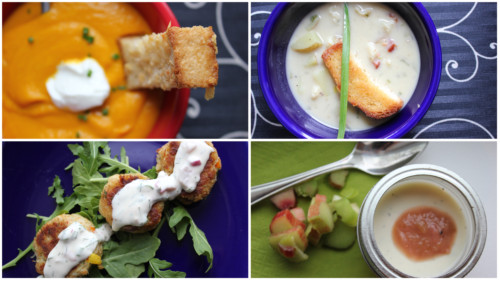
Dear Alain,
We love cooking and would love to learn. When are your next classes, this year or next?
Thank You,
Ray
Hi, We just heard about this. Coming up to Canada to Newfoundland, my grandfather’s home, and are looking to do food trips along the way to enhance the Canadian experience for us. Do you still offer cooking classes? Thanks,